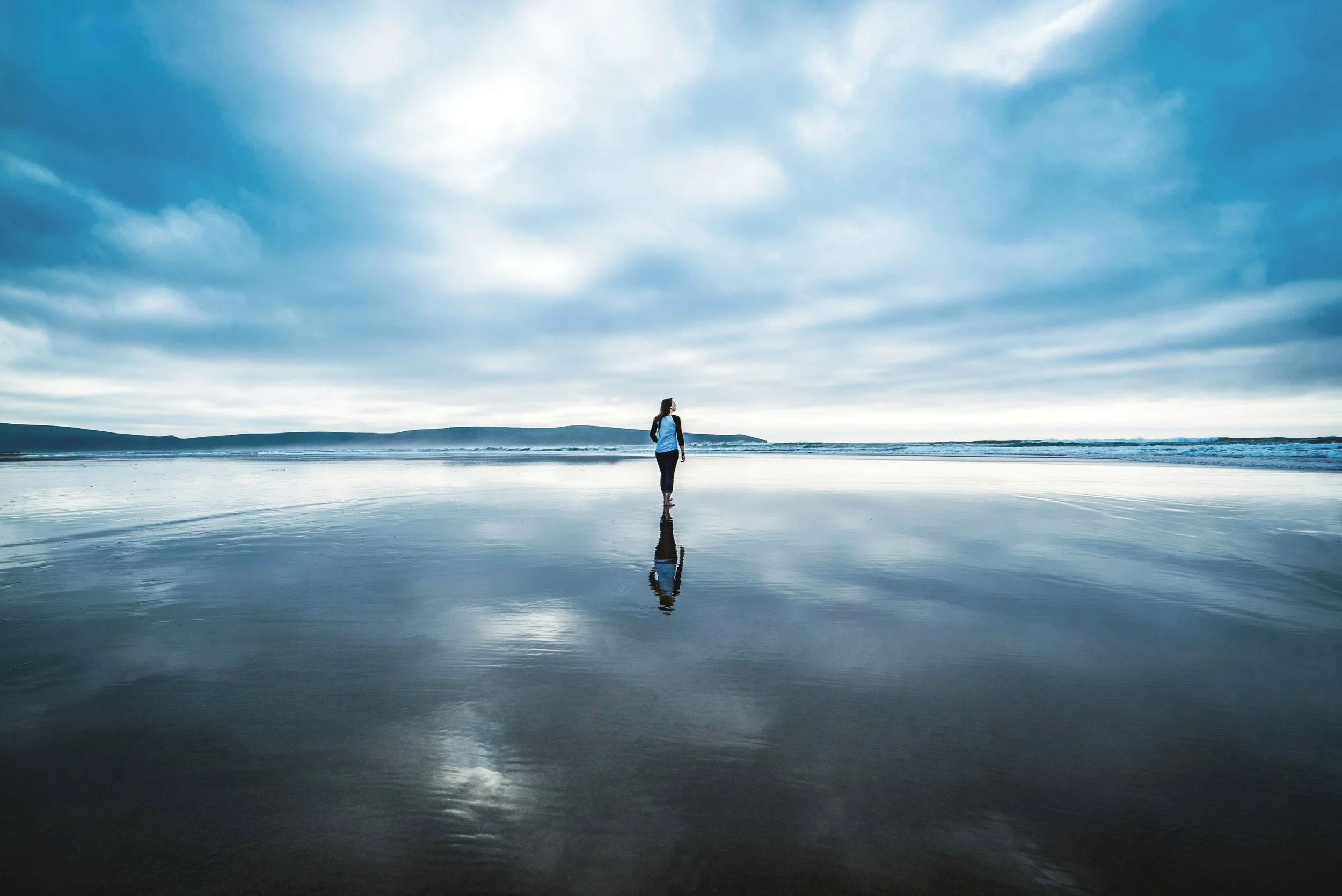Transitions
Photo by Joshua Sortino
When our path seems unclear and reality precarious, where do we turn?
In this talk Zuisei and the sangha take this question to heart. Zuisei reminds us, as the famous Machado song says, that “the path is made by walking.” Whether it seems laid bare for miles ahead or the view appears obscured, we can ever only take one step at a time.
This talk was given by Zuisei Goddard. See below for transcript.
Transcript
Transcript has been lightly edited for clarity.
I wanted to talk about transitions today, but before I do that there are some people who have been asking me again about the process of becoming a student—what it entails and how it's different from not being a student. I briefly want to touch on that again.
We're here and we're practicing together. We're exploring reality and the nature of the self, of life, together. How you come and go is completely up to you. For example, a number of people have passed through our Wednesday gatherings. Others I've worked with one-on-one, or they’ve come to half-day sits, other retreats, or classes. People will come and go. But when we say we want to become students, we're saying that practice and the spiritual path are important enough to be either at the center or close enough to the center of our lives. We're saying we want help, we need help, and we want to do this together and hold each other accountable. So, if somebody is just coming to Wednesdays or just signs up for one-on-one teaching, it's completely up to them when, how much, and whether they do it or not. If somebody goes through the process of becoming a student, if I don't see them, I'll go look for them and ask, “What happened? Where are you?” Part of the process of becoming a student is you give me permission to do that, essentially. I will continue to work with anyone who wants the teachings. But saying that you want to become a formal student is how I understand that we have become accountable to one another. I'm accountable to you, and I'm committed to you. So I'm committed to working with you, hopefully in person. Then, you're committing, saying to me, yes, I want to do this, and I'm asking you to help me to do this. That's how I understand it. There are no requirements in terms of needing to show up for a particular number of retreats. But I hope that you’ll show up. I am asking people to sign up for one of the memberships that I created that includes face-to-face teaching. That way we can be sure that at least once a month, we’re meeting one another. This also gives me a bit of financial support. The process itself is to sit Tangaryo, during which you will ask, in your own words, for the teachings.
So transitions—first I want to acknowledge how precarious it is to be a human being. It’s precarious to be in this body and mind and have them remain in balance. It’s also precarious to live in this world—perhaps now more than ever, as we see everything that is going on on the planet. Transitions are this liminal space where we have the potential to feel that vulnerability a little more keenly.
I want to start by sharing a story. Some of you know this story, and hopefully some of you don't. It begins like this.
At the end of the world, a bricklayer stands at the edge of the ocean, looking out over the water. Beyond the edge of what he can see, he senses another land—a land that will save him. Up in the town, the Weepers are weeping for the end of the world. Recognizing the pointlessness of things, they decide to get rid of everything. They spend all their time chanting, singing, and prostrating, waiting for the end of the world and for their transcendence. The Ragers also understand the futility of things, but their approach is to destroy. They go down and burn all the fields. They kill all the animals. They cut all the flowers. They destroy anything that wouldn't be destroyed quickly and naturally. And they are just partying as they wait for the end of the world.
The bricklayer chooses to do neither. He decides he's going to find a way into the unknown. He doesn't know how to swim. He doesn't know how to cross the ocean, though he has dreamt that he will cross it. So first he gets his wheelbarrow and pushes it into the ocean, and it floats. However, the moment he puts even a little bit of weight on it, the whole thing sinks. Then he goes back up and loads his wheelbarrow with a bunch of bricks, which he has made himself. He takes it down to the bottom of the hill, right to the edge of the ocean, and he builds a canoe of bricks. With a lot of effort, he pushes it into the water, and immediately it turns over and fills with water. He empties it. It fills with water again, and then a wave comes and smashes the whole thing into bits. Then, he thinks to himself, I'm not a floater. I'm a builder (remember this).
He goes back up the hill, gets another load of bricks, brings them down to the edge of the water, and then he lays two steel rods in the sand. He begins brick by brick. He dives down, which he does not know how to do, but he's learning as he's doing it. He takes a brick and places it on the sand. He can't obviously use mortar or anything underneath the water. So he's placing the bricks snug against one another to make a path. He's stepping on the path as he lays another brick. He steps on it, and then he lays another brick.
Days and weeks go by like this as March turns into April, and the weather begins to get a little warmer. At this point, he's learned how to float, how to dive, and how to hold his breath underwater so he can continue to build his path. He's also running out of bricks. One day, it’s over. He stands at the edge of the ocean,\ and sees there's about 120 feet worth of path and thousands upon thousands of miles in front of him. He has no idea what he is going to do next.
For days now everything has been completely quiet, and he realizes everybody has gone. He doesn't know where they've gone. He begins to wonder if this is it. Is this the end of the world? The only thing that responds is silence. So, he decides, tomorrow I go. He wakes up very early, at the crack of dawn. He packs just a couple of things—the last few pieces of stale bread. He puts it in a bundle and ties it onto his back. He wades out into the water, walking on his path.
In the beginning the water just goes up to his waist, and he keeps walking. Then it goes all the way up to his neck, and then it goes all the way up almost to his nose. He's just barely keeping his nose above the surface of the water. He gets all the way to the very edge of the path and can't step any further. He has no more bricks, but he knows he cannot go back. There’s no other path back there. There’s no other way. So, he takes a deep breath. He waits for the right moment. He's still watching all the way to the end of the horizon, to see if there's something that he can see. It seems like the whole world is holding its breath. And then, he takes the next step.
There’s actually a what happens next, but I'm not going to tell you what that is. It's not my story. It’s by Ursula Le Guin, and it's called “Things.” You can look it up.
This is exactly what transition feels like to me. I cannot tell what’s in front of me, but I know I have to step. The image that I've added for myself is that I actually have the bricks with me in my pockets. They are the skillful means, the tools that I have learned over time, particularly from Buddhism—though not exclusively. When I think I've run out of bricks, I just have to dig a little deeper, pull another one out, and lay it out on the sand. Then I take that step. Then I think I have nowhere to go, and there's this moment, still, of anxiety. There's this moment of fear—fear of disappearing, fear of dying, fear of not being able to take that next step, fear of failing. But if I can get myself quiet enough, I remember, oh, I have another brick. Then I pull that one out, lay it down, and take another step. Just as that famous song/poem says, “The path is made by walking.” I want to know where it will end because it would make me feel safer, but I realize I can't. I can't know. I have to make that path as I walk it. I have to trust that I will know where to step and where to place that brick. If I don't know, then I will place it and figure out whether it’s right or needs to be adjusted. I trust that I won't step off into the void and drown—although at times it has felt almost like it. I suppose that it’s faith, that trust. It’s a kind of faith.
That's actually all I want to say.


